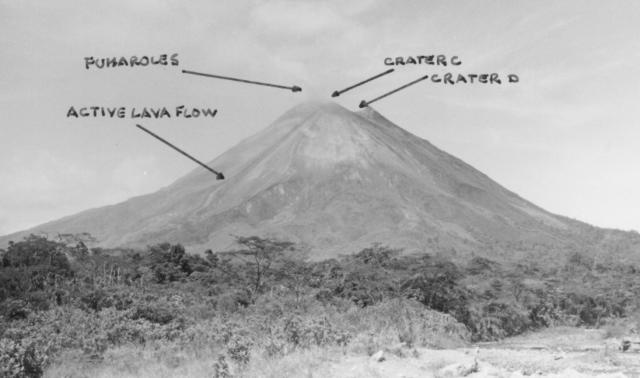Report on Arenal (Costa Rica) — March 1992
Bulletin of the Global Volcanism Network, vol. 17, no. 3 (March 1992)
Managing Editor: Lindsay McClelland.
Arenal (Costa Rica) Lava flows continue to advance; Strombolian activity weakens
Please cite this report as:
Global Volcanism Program, 1992. Report on Arenal (Costa Rica) (McClelland, L., ed.). Bulletin of the Global Volcanism Network, 17:3. Smithsonian Institution. https://doi.org/10.5479/si.GVP.BGVN199203-345033
Arenal
Costa Rica
10.463°N, 84.703°W; summit elev. 1670 m
All times are local (unless otherwise noted)
The two lava flows active in February continued to descend the W and WSW flanks in March (figures 45 and 46). The WSW-flank flow bifurcated, with one tongue advancing 50 m in early March to 730 m elevation, before stopping in mid-month. Near 1,100 m elevation, the W-flank flow also divided; one lobe advanced W down a valley, while the other diverged to the WSW, overflowing the September 1991-March 1992 flows (figure 46). The lava flow advanced an estimated 10-20 m daily on the upper slope, and 2-5 m daily on the gentler, lower slope. The most active, northern- and southern-most, lobes extended to 870 m and 830 m elevation, respectively, the first time in several years that lava had reached that elevation on the WSW flank.
 |
Figure 45. Photograph of Arenal by G. Soto, showing its summit craters and active lava flows, 16 March 1992. Courtesy of ICE. |
Strombolian activity continued at a significantly decreased rate and intensity, consisting primarily of sudden or rhythmic degassing events, with little or no pyroclastic ejection. In addition to intense fumarolic activity in Crater C (the active crater), intense steaming was observed between craters C and D (300 m E of Crater C).
Seismic activity was at moderate levels, with an average of 15 earthquakes recorded daily (at station FOR, 4 km E), and peaks on 4, 25, and 30 March. Increases in tremor were recorded on 11, 13, and 18 March.
Geological Summary. Conical Volcán Arenal is the youngest stratovolcano in Costa Rica and one of its most active. The 1670-m-high andesitic volcano towers above the eastern shores of Lake Arenal, which has been enlarged by a hydroelectric project. Arenal lies along a volcanic chain that has migrated to the NW from the late-Pleistocene Los Perdidos lava domes through the Pleistocene-to-Holocene Chato volcano, which contains a 500-m-wide, lake-filled summit crater. The earliest known eruptions of Arenal took place about 7000 years ago, and it was active concurrently with Cerro Chato until the activity of Chato ended about 3500 years ago. Growth of Arenal has been characterized by periodic major explosive eruptions at several-hundred-year intervals and periods of lava effusion that armor the cone. An eruptive period that began with a major explosive eruption in 1968 ended in December 2010; continuous explosive activity accompanied by slow lava effusion and the occasional emission of pyroclastic flows characterized the eruption from vents at the summit and on the upper western flank.
Information Contacts: G. Soto and R. Barquero, ICE; G. Alvarado, GEOMAR, Germany; M. Fernández, Univ de Costa Rica.


